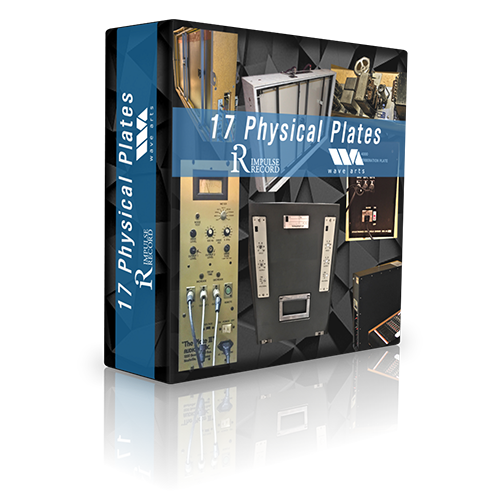
List Price $109.95
Your Price $99.95
You Save $20.00
Plates
17 different Plates – 185 Files – 331 megs.
Sampled in 7 Different Countries including: Australia, Austria, Finland, Sweden, Switzerland, Slovenia, USA
(8) German 140s that include Mono, Mono Tube, Valve, Transistor and ST models
Many pieces of gear listed have been used on major recording artists, albums and Grammy productions.
Full Listing of Plates:
Aud (Audicon “The Plate II”) Memphis, TN
Brick – Chicago, IL
EPlate I (ECOPLATETM – trademark of Studio Technologies, Inc) Chicago, IL
Eplate II – Appleton, WI
Eplate III – Sweden
German 140 Mono – Nashville, TN
German 140 Mono Tube – Nashville, TN
German 140 Valve – Slovenia
German 140 ST – Cleveland, OH
German 140 ST – Australia
German 140 ST – Portland, OR
German 140 T – Los Angeles, CA
German 140 T – Finland
German 240 (Gold Foil) Los Angeles, CA
German 240 (Gold Foil) San Francisco, CA
Lawson – Nashville, TN
Stock (Stocktronics) Finland.
General Overview
Every plate varies according to how it’s been tuned, so there are virtually no two plates exactly alike, even when made by the
same company and then given years of use and in some cases “stored” and/or reconditioned and re-tuned. In addition, the
condition of drivers, pickups, the addition of upgrades made to a plate unit, along with the audio paths to and from each piece
of gear, can and obviously do play a heavy roll in final sound and impulse response capture.
Physical Plate Overviews
These overviews are general and with EQing almost any plate finds its use and purpose. It’s also important to note that many
engineers, back in the day, used delays before entering the plate, to either give it pre-delay, in its truest sense, or for
different spacial environments and different room reverb feel. Because many of today’s engineers are more accustomed, to dialing
in reverb, without much need for tweaking, beyond dry, wet signals and minimal EQing, there are numerous files that have been
pre EQd to sound like a given space, along with hybrid versions where early reflections (usually up to 100ms where your ears
tell you, “That’s a big bright space and I hear the instrument coming from stage left,” etc) have been employed.
What Files Are Included
With the physical plates, the truest and most accurate representation of the plates have been sampled. This was a massive project
with engineers and studios literally from around the globe. Knowing the potential of the project, moving forward with studios
who were well regarded, achieving a great deal of success in the industry, recording some of the biggest names, was very
important for a number of reasons. Firstly, they know their gear, it’s behaviors and what works best. Secondly, the gear had
been used on numerous Grammy nominated and winning productions. Lastly, knowing that time was a commodity, studios and engineers
were given specific criteria in regards to how to best implement the library goals with a high standard of impulse response
capture and could deliver under that criteria.
Because time was critical, the “sweet” spots of each plate was recorded. In simple terms, for some plates, because dampers were
working “somewhat” but still had a beautiful sound, there were only a handful of samples and impulse captures that took place
and for others, a good number more samples were captured with a wide array of impulse response files. One could argue the
difference in the files of a 2.5 second sample over a 2.75 second sample, but the reality, even for most award winning
engineers, is that between software adjustments alone, time could be conserved and with some vintage gear, trying to push
outside parameters of decay change, could only be effected so much.
With that in mind, there is a huge selection of plates and DSPs and there really is something for everyone in the mix. This
library will compete with anything out there and then who has it all? Who has virtually every plate manufacturer known in one
pristine library, all at 96/24 sonic resolution – Convology does! Impulse Record has gone where no other company or library
has, capturing almost any and every physical plate model manufactured in painstaking detail!
Here are some plate generalities and basic characteristics.
Aud (Audicon) – middle of the road – somewhat bright, similar in overall size to their West German plate competition, with a
steel plate thickness a little under the 1/64 of an inch used by the Germans, yielding a brighter sound.
Brick – some variations with models, but the 4’ X 4’ plate was typical. For being half the size of the 140, sounds quite good.
The Brick is not as warm, but is very useful when wanting a rich plate sound and to bring out a particular sound such as a snare.
Eplates (ECOPLATESTM trademark of Studio Technoliges, Inc) – tend to be brighter and a little more metallic sounding. Useful to
bringing certain production elements out in the mix when you need it to cut through. These units were a little smaller than the
German 140 plates.
German 140s – For many, the 140s are viewed as king of the hill for a number of reasons. They were the first and came to market
in the late 1950s. They tend to be a little warmer, tend to replicate, as they were originally designed, the sound of a concert
hall and with limited EQing can for the most part, more readily replicate a dark, bright or a warm sounding room, etc. The need
to scoop low end EQ might be useful when applying to certain instruments and voices, to avoid the bass multiplier effect. There
are beautiful sounding files in every 140 model sampled – try them all along with very cool hybrid impulses that really are a
solid edition to anyone’s convolution library!
Lawson – tends to be brighter and a bump in the lower mids tends to warm them up. This unit was designed and built by Gene Lawson
who continues to make microphones today at his shop in Nashville, TN. His microphones are well regarded and his tenure in the
business is remarkable.
Stocktronics manufactured in Sweden. Only a little over 250 of these units made in their entirety and are very rare. Impulse Record
was lucky to get these impulse response files recorded from Finland The original owner/designer Lars Liljeryd, talks about the
Stocktronics plate and made these comments on the manufacturing process. “The specially manufactured stainless steel used in
the Stocktronics 4000 was totally unique with it’s 0.3 mm thickness and extremely low “pile-height”. Thus the steel sheets were
2-D stretched in a stretching bench at the steel manufacturer and thus became very flat, before cutting it to size. This
two-dimensional stretching process also cold-forged the steel so it became even harder, thus producing proportionally longer reverberation times at higher frequencies than any steel quality used by the competition. Therefore it had a very special sounding reverb, liked by many and disliked by some, as it sounded a bit synthetic. It however had a very high resonant density so it could cope extremely well with high frequency impulsive sounds and still sounded smooth.”
German 240 – darker sounding. Weighing 148 lbs with dimensions of 1’ X 2’ X 2’. Some say better on shorter settings and for
sound sources like drums. Originally designed as a way to make the original 140 (4’ X 8’) in a smaller and lighter box.
It really was a technological feat for its time. Both versions of the 240s sampled, tend to be darker in tone and sound as
most do, when searching online with user comments. They use a gold foil plate and are a hybrid between the original large
140 plate and early analog to digital rack mount and smaller floor units, although the 240 is totally analog. The thickness of
the gold foil plate is 18 microns (very thin like aluminum foil – note that average human hair thickness is between 40 – 50
microns)
